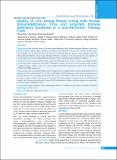Please use this identifier to cite or link to this item:
https://hdl.handle.net/20.500.14356/1480| Title: | Quality of Life among People Living with Human Immunodeficiency Virus and Acquired Immune Deficiency Syndrome in a Anti-Retroviral Therapy Clinic |
| Authors: | Baral, Rojina Thapa, Usha Khatiwada, Dipendra |
| Citation: | BaralR., ThapaU., & KhatiwadaD. (2019). Quality of Life among People Living with Human Immunodeficiency Virus and Acquired Immune Deficiency Syndrome in a Anti-Retroviral Therapy Clinic. Journal of Nepal Health Research Council, 16(41), 405-409. https://doi.org/10.33314/jnhrc.v16i41.1533 |
| Issue Date: | 2018 |
| Publisher: | Nepal Health Research Council |
| Article Type: | Original Article |
| Keywords: | ART HIV/AIDS Quality of life |
| Series/Report no.: | Oct-Dec 2018;1533 |
| Abstract: | Abstract Background: The increasing burden of Human Immunodeficiency Virus/Acquired Immune Deficiency Syndrome and its association with the stigma, disability, less productive life, diminished immune has overall affected the quality of well being. There are also many factors that directly or indirectly affect the quality of Life of People living with Human Immunodeficiency Virus/Acquired Immune Deficiency Syndrome. Thus, this study aims to assess Quality of Life among people living with Human Immunodeficiency Virus/Acquired Immune Deficiency Syndrome. Methods: A cross-sectional analytical study among 100 individuals of age 18 years and above and diagnosed from 6 month and above attending the ART clinic of Bharatpur Hospital was carried out between using simple random sampling technique. Quality of life was evaluated using World Health Organization Quality of life questionnaire (WHO QOL-BREF instrument). Results: This study reveals that the Quality of Life median scores were highest for the environmental domain (25±2.6) and lowest for the social domain (11±1.4). The overall Quality of Life median scores in the other two domains were physical domain (23±2.4), and psychological domain (19±3.1). The Quality of Life scores of all four domains were strongly co-related with the total measure of the quality of life. The strongest correlation was seen in psychological domain .Sex, Education, Marital status, Cause of HIV, Co-morbidities of illness, and Family support was statistically associated with overall Quality of Life. Conclusions: Higher education, Good family support and no co-morbidties to the illness has a greater impact in improving the quality of Life. Keywords: ART; HIV/AIDS; quality of life. |
| Description: | Original Article |
| URI: | http://103.69.126.140:8080/handle/20.500.14356/1480 |
| ISSN: | Print ISSN: 1727-5482; Online ISSN: 1999-6217 |
| Appears in Collections: | Vol. 16 No. 4 Issue 41 Oct - Dec 2018 |
Files in This Item:
| File | Description | Size | Format | |
|---|---|---|---|---|
| 1533-Manuscript-7825-5-10-20190221.pdf | Fulltext Article. | 186.2 kB | Adobe PDF |  View/Open |
Items in DSpace are protected by copyright, with all rights reserved, unless otherwise indicated.
